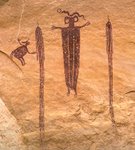Information received from the Centers for Disease Control and Prevention (CDC)
Monday, September 09, 2013
Today the City of Baker City received the following information from the Centers for Disease Control and Prevention (CDC).
- 81 goats tested; 1 positive for C. ubiquitum (making it unlikely source)
- 64 elk tested; 1 positive with species still unknown, but negative by C. parvum and C. hominis–specific PCR
- 10 human specimens tested; 9 positive; 7 are C. parvum IIaA15G2R1; most recent 2 resequencing
- 4 cattle tested (5 listed on packing sheet, but only 4 in box); all negative
- 4 water samples tested; all negative
- 1 positive EPA method 1623 slide (4 oocysts present) tested; could not detect Crypto DNA
Day Late and a few Cow Pies Short
I said in an earlier blog that they might not get positive results because of the haphazard late sampling (after we found the cow pies on the trip of the 19th) and not asking Dennis Dorrah and I to go along to show them where all the cow pies were. I had already notified Dr. De bess of our findings.
The cattle tests were taken on samples that were from some cow pies that had been there for an unknown length of time, and it is not known if they are from calves that have been in the watershed. It is the calves that usually test positive for C. parvum. Calves also shed more crypto when they are younger, like July in this case.
They apparently only tested four or fewer cow pies and there is no way to know whether the cow pies they tested were from the calves. They tested 64 elk scat samples.
They probably did not test all the fecal material that Dennis and I found. They should have tested the calves that are in the herd and were in the area (Dennis Dorrah, Clair Button, and I, saw them at least twice and they were nearby when they tested) for C. parvum, but I am quite sure they didn't, and I doubt if they will. It is in the state's and the city's interest not to find a culprit in this case due to liability issues. That is what happened in the Milwaukee outbreak--no definitive cause found.
Also, Dr. De Bess told me that the staining of the crypto oocysts found in the 913 oocyst water sample might make it impossible to genotype the oocysts, i.e., determine whether they were C. parvum. That was a huge mistake. I think that means they didn't split the sample so that they could test (genotype) any unstained material from the sample to find out whether it is C. parvum, and the staining, as Dr. DeBess suggested to me that it might, destroyed the possibility of matching the 913 water sample oocysts to the C. parvum oocysts found in diseased patients. Not finding C. Parvum in the cow pies is also problematic, in terms of establishing the responsibility of cattle, but they didn't and probably won't test the calves. All the research, plus the results showing it isn't in the elk, suggests that it may have come from cows.
- Why did Dr. De Bess ignore my phone call and not ask Dennis and I to go along
even though I alerted him to our findings prior to his prominent trip with the
Herald reporter(s) to Elk Creek?
- Why didn't they try to get cow pie samples from
the calves that were in the area during our trip on the 19th, during their sampling mission, or during
the following weeks when Councilor Dennis Dorrah went up to try and and repair the fence to keep the cows out and
yet still found them in the watershed?
- Why did the Centers for Disease Control (CDC), or the state, destroy the ability to genotype
the original 913 oocysts in the original water sample to see if it was Cryptosporidium parvum? By apparently staining the whole sample and
not keeping anything aside for genotyping, that information will likely never be known.
Here are seven important points to consider (there are no doubt others):
- Four cow fecal material samples (compared to 64 elk samples) does not prove that cows weren't responsible.
- The results do not remove the responsibility of Public Works to report to the Council about crypto or cows in the watershed.
- Why did they take 64 elk fecal samples, 81 mountain goat samples, but only 4 cow fecal samples?
- Why was the effort by Dr. De Bess and his CDC companions so weak with regards to testing fecal material from the cows in the vicinity when he made his investigation? 4 cattle samples and 64 elk samples? There was ample fecal material outside the watershed fence when the Councilors and I made our trip to the watershed that could have been genotyped to determine whether the cows carried Cryptosporidium parvum that matched the Cryptosporidium parvum found in the Baker City citizens suffering from cryptosporidiosis.
End Note:
At least one Baker City cancer patient contracted symptoms resembling those of cryptosporidiosis in July, and he died not long thereafter, before experimental treatments, an individualized immunotherapy vaccine, could be implemented in an effort to save him.
__
End Note:
At least one Baker City cancer patient contracted symptoms resembling those of cryptosporidiosis in July, and he died not long thereafter, before experimental treatments, an individualized immunotherapy vaccine, could be implemented in an effort to save him.
__
_____













No comments:
Post a Comment